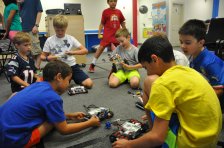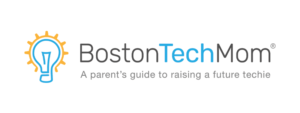Collaboration is key to successful FIRST LEGO League season
Attending a FIRST LEGO League (FLL) robotics competition is exciting. As energetic music pumps through the venue, it’s like watching a beehive, with various competitions happening simultaneously and competitors circling around tables with fists pumping as they nervously watch their robot complete various tasks.
“All of the kids’ jaws dropped and they were in awe at how cool the event was,” marvels Dave Gutierrez, who co-coached a fledgling FLL team from Empow Studios, the ‘Empowerers,’ to a qualifying event last season in Lawrence, MA.
“The kids went from not knowing how to code or design robots, to winning 1st place in the teamwork category of our qualifier,” adds Gutierrez. “For our first FLL team, I’d say it was a big success.”
LEGO robotics events have taken the U.S. by storm. There’s FIRST LEGO League Jr. (ages 6-10); FLL for elementary and middle school age students, FIRST Tech Challenge (middle & high school), and FIRST Robotics Competition (FRC) for high school competitors.
FLL competitions involve building a robot using a LEGO®MINDSTORMS® kit. The autonomous robots are designed to complete missions, such as collecting rings and navigating obstacles within a 2.5 minute time frame. The competition also involves a research project and team presentation that focuses on a real-world problem and an original solution. The theme of the 2015-16 FLL season was ‘Trash Trek.’
“Our school had two teams and we did presentations on preventing plastic rings from harming animals and on nuclear waste,” says 12-year-old FLL competitor Hallie Farmer from Bolton, MA.
This season’s theme is ‘Animal Allies’ which involves completing a series of robotic tasks that center on animal welfare, such as moving a LEGO shark, working with a LEGO guide dog and placing a LEGO gecko on a ‘biomimicry wall.’ “The kids this year are really excited about the animal theme,” notes Gutierrez.
To start, teams put together their boards and create the LEGO objects that will make up the official course. During the next couple of months, they will focus on programming their LEGO robots to complete the missions while creating one presentation per team that will focus on a real-world animal concern and an original solution.
The teams are guided by ‘Core Values,’ which emphasize having a fun, friendly competition, and cooperating as a team. One of the mottos is: ‘What we discover is more important than what we win.’
Come One, Come All
LEGO® has purposely been inclusive in how teams form. Cheryl Temple, who helped create a middle school team as a mentor and Assistant Principal of Florence Sawyer School (FSS) in Bolton, MA, points out the diversity among teams.
“We noticed at the first event that many FLL teams are run by families without a connection to a school,” she says. “One team was run by a family out of their home, another team was run by a Girl Scout group, and another team was part of a home-school group.”
The caveat is that it’s not simply a matter of having kids play with LEGOs. Temple’s school-based teams, one of which ended up with the 3rd highest score at the state competition, was fortunate to have three robotics veterans leading the group. Team coach and Worcester Polytechnic Institute (WPI) graduate Deanna Clark has a background in robotics, was mentoring a high school team and had been looking for potential outreach ideas. “We came up with starting a FLL team,” she says. “I was on FRC Team 20, ‘The Rocketeers’, in high school, and the team and my mentors are what inspired me to study engineering at college and to become a mentor once I graduated.” Clark was assisted during the season by fellow WPI graduate and former FRC competitor Zac Temple, along with one of the team members’ grandparents, Mike Hoeffler, a retired engineer.
“We absolutely relied on parents and volunteers to help out,” adds Clark. “We could not have done it without everyone’s help.”
The ‘Empowerers,’ led by Gutierrez and Empow Studios Founder Leonid Tunik, also had assistance from FLL veterans their first year. “One of our parents from our After-School Club actually used to work for FIRST, so he gave us a lot of insight,” says Gutierrez. “We also had a guest speaker on our first day who went to the world championships.”
Though coaches can be experts, it’s the students who must create the robots. “The kids really need to ‘own’ it,” notes Gutierrez. “They are the ones that need to be creative, and let their imaginations turn to reality. From the build and coding of the robot, to the design and printing of our team t-shirts, that was all the kids’ responsibilities. We were there to coach, guide, and give feedback to them.”
Teaching Teamwork
Coaches should be fully versed on FLL rules and the season’s mission. There are tutorials for LEGO®MINDSTORMS® that are used to train the kids in the basics of robot creation. However, FLL dictates that the kids should be making all the critical decision in the robot-building, programming, project development and presentations. The role of adults is to teach kids how to operate the technology, but then to have team members brainstorm and determine specifics to ensure it’s a learning process for them.
Coaches and teams are also expected to promote FLL Core Values and Gracious Professionalism. Teams are graded on these via undercover judges and team interviews.
Ideally, teams begin organizing in the summer and start reviewing the challenge as soon as it’s released. This year, the release date was August 30. The first local qualifying events begin in November and the state competition takes place in December.
Clark, who ended up creating two teams at Florence Sawyer School last season, found that the biggest challenge was getting all of the students on the same page. “In the beginning, we spent a lot of time doing coding and build lessons with separate robots,” she recalls. “As it got closer to the competition, though, we needed to consolidate all of the ideas into one machine. It was very difficult for everyone to take all of the different mechanisms, programs and drive bases and turn it into one fluid system that effectively completed the game challenge.”
“I’d say the biggest thing we learned was how dedicated everyone needs to be,” says Gutierrez. “From the kids, to the coaches, to the parents. There’s a lot of work to be done both in and out of the studio.”
Looking Ahead
“The FLL teams at Florence Sawyer School have been an excellent experience,” says Clark. “I heard over and over again that this was something that parents had been wanting for their kids for a while.”
Clark, who also served last season as a mentor for the Nashoba Regional High School FIRST team, the RoboChiefs (Team 1768), says the younger students were given a chance to watch the older kids build and compete. “They are excited about the opportunity to do robotics again when they get to high school,” she notes. “FLL is a wonderful program and I am so glad I got involved. It is a great opportunity to have a positive impact on the students and get them interested in STEM early on.”
Gutierrez and Tunik, co-coaches at Empow Studios, are excited about launching the new season and adding additional FLL teams (ages 9-14), which meet in Lexington. “We had our first practice on September 3rd and we’re still admitting team members through September for anyone who may have missed the start date,” says Gutierrez.
For more information about the team or to register, contact Empow Studios. To talk to a coach: 617-395-7527






